Jodhpur travel - India, Asia
Jodhpur, located in the western Indian state of Rajasthan, is known as the "Blue City" for its distinctive blue-painted houses that surround the majestic Mehrangarh Fort. Founded in 1459 by Rao Jodha, the city serves as the administrative headquarters of the Jodhpur district, it is the second-largest city in the state.
Jodhpur's unique charm lies in its rich history, with stunning landmarks such as the Umaid Bhawan Palace, a blend of art deco and Indo-Saracenic architecture, and the vibrant bazaars that offer a glimpse into local handicrafts and textiles. The city's strategic location near the Thar Desert makes it a popular base for travelers exploring Rajasthan, while its warm, sunny climate has earned it the nickname "Sun City." Visitors are drawn to Jodhpur not only for its historical significance and architectural beauty but also for its delicious local cuisine, including dishes like dal baati churma and gatte ki sabzi, which reflect the culinary traditions of the region.
Population: Estimate 1,600,000 people (as of 2024)
Economy: Jodhpur is an thriving economy based on agriculture, handicrafts, industry, and tourism. Jodhpur district has a significant agricultural sector, with around 60% of the total land area under cultivation. Tourism is also a key economic driver, with Jodhpur known for its heritage hotels and historic attractions like Mehrangarh Fort and Umaid Bhawan Palace.
The city's nickname also come with "Blue City" and its desert setting make it a popular tourist destination.
Landmarks: Mehrangarh Fort, Umaid Bhawan Palace, Jaswant Thada, Clock Tower (Ghanta Ghar), Toorji Ka Jhalra (Toorji's Step Well), Mahamandir Temple, Rao Jodha Desert Rock Park
India
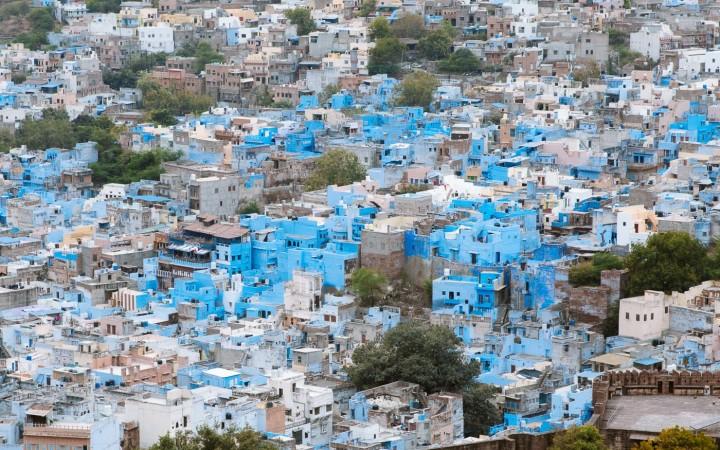
Overview of Jodhpur
History & Cultural Influence
Jodhpur, founded in 1459 by Rao Jodha, is steeped in history and cultural significance, having served as the capital of the Marwar kingdom. Its strategic location on the trade route between Delhi and Gujarat facilitated flourishing commerce in opium, silk, and other goods, contributing to its wealth and prominence. The city is dominated by the imposing Mehrangarh Fort, which not only showcases exquisite architecture but also houses a museum that reflects the rich heritage of the region.
Culturally, Jodhpur is known for its vibrant arts, music, and culinary traditions, with local specialties like Mirchi Bada and Mawa Kachori gaining popularity. The city's unique blue-painted houses and lively markets enhance its charm, while festivals like Jodhpur RIFF celebrate its artistic heritage. This blend of historical significance and cultural vibrancy shapes Jodhpur's character, making it a captivating destination for travelers seeking to explore Rajasthan's royal legacy.
Interaction with The Locals
Visitors to Jodhpur can expect warm and welcoming interactions with the locals, who are known for their hospitality and friendliness. The city has a population of approximately 1.6 million people, predominantly consisting of Rajasthani ethnic groups, including Rajputs, Marwaris, and Jats, which contributes to its rich cultural diversity.
The general attitude towards tourists in Jodhpur is positive; locals often take pride in sharing their heritage, traditions, and stories about their city. Visitors will find that many residents are eager to assist and engage in conversations, especially in markets and historical sites.
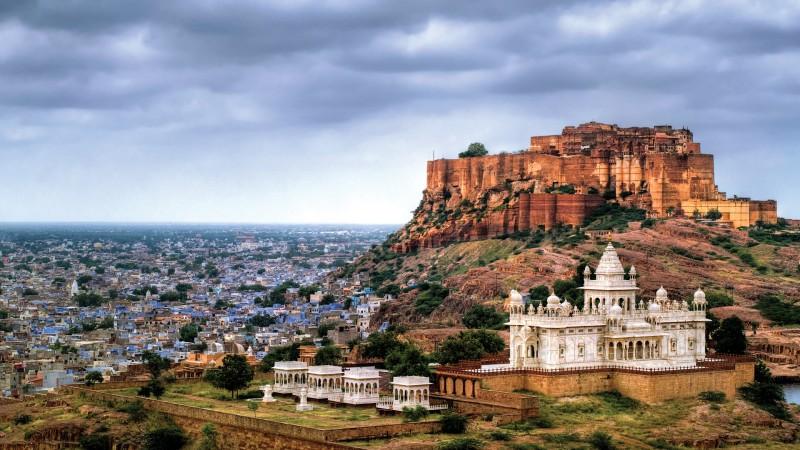
Mehrangarh Fort - © gather
Top attractions in Jodhpur
A captivating destination known for its stunning architecture and vibrant culture. The majestic Mehrangarh Fort, perched high above the city, offers breathtaking views and a deep dive into Rajasthan's royal history, while the Umaid Bhawan Palace showcases opulent luxury and architectural grandeur. Wandering through the blue-hued streets of the old city and visiting the bustling Sardar Market adds to the charm, making Jodhpur a must-visit for any traveler.
Mehrangarh Fort
Location: Fort Rd, Jodhpur, Rajasthan
Mehrangarh Fort, one of India’s largest and most awe-inspiring forts, stands majestically 400 feet above Jodhpur. Built in 1459 by Rao Jodha, the fort showcases stunning architecture and houses a museum filled with royal artifacts. As you explore, you’ll be treated to panoramic views of the "Blue City," creating a truly unforgettable experience.
Umaid Bhawan Palace
Location: Cantt Area, Jodhpur, Rajasthan
Umaid Bhawan Palace, an architectural marvel constructed between 1928 and 1943, blends Indo-Saracenic and Art Deco styles. This magnificent palace serves as a luxury hotel, museum, and residence for the royal family. Surrounded by lush gardens, it offers you a glimpse into the opulent history of Jodhpur’s royalty.
Jaswant Thada
Location: Near Mehrangarh Fort, Jodhpur, Rajasthan
Jaswant Thada, a serene marble cenotaph built in memory of Maharaja Jaswant Singh II, is known for its intricate carvings and tranquil gardens. This peaceful spot also provides picturesque views of Mehrangarh Fort and the surrounding landscape, making it a must-visit for those seeking a blend of history and beauty.
Clock Tower (Ghanta Ghar)
Location: about 10 km from the north of Jodhpur, Rajasthan
The Clock Tower, a prominent landmark in the vibrant Sardar Market, is surrounded by bustling bazaars brimming with spices, textiles, and handicrafts. Built in the early 20th century, it’s the perfect place to immerse yourself in local life, explore the lively market, and shop for unique souvenirs.
Toorji Ka Jhalra (Toorji's Step Well)
Location: Near Clock Tower, Jodhpur, Rajasthan
Toorji Ka Jhalra, a beautifully restored stepwell from the 1740s, features intricate carvings that offer a glimpse into the region’s historical water conservation methods. This stepwell is not only a piece of history but also a popular spot for photography and relaxation, providing a quiet escape within the city.
Rao Jodha Desert Rock Park
Location: Near Mehrangarh Fort, Jodhpur, Rajasthan
Rao Jodha Desert Rock Park, established in 2006, spans 72 hectares and showcases the natural desert landscape and unique vegetation of the region. With its walking trails and educational exhibits, this ecological park is a haven for nature enthusiasts looking to explore the flora and fauna of Rajasthan.
Mandore Gardens
Location: Mandore, Jodhpur, Rajasthan
Mandore Gardens, located just 9 km from Jodhpur, offers a peaceful retreat rich in history. The gardens feature beautiful cenotaphs and temples dedicated to the Marwar royal family, providing a serene escape from the city’s hustle and bustle. It’s an ideal spot for those seeking tranquility amidst Jodhpur’s cultural heritage.

Umaid Bhawan Palace - © jodhpurtourism
Must-Try Dishes in Jodhpur
Jodhpur's culinary scene is a feast for the senses, offering must-try dishes like Mawa Kachori, a sweet, deep-fried pastry filled with rich mawa and drizzled with sugar syrup, making it a local favorite. Don’t miss Mirchi Bada, a spicy snack featuring large green chilies stuffed with a tangy potato filling and coated in gram flour, perfect for those craving a bold and flavorful bite. These iconic dishes capture the essence of Jodhpur’s vibrant and spicy cuisine.
Mirchi Vada
A popular street food in Jodhpur, Mirchi Vada features spicy green chili peppers stuffed with a tangy potato filling, coated in gram flour batter, and deep-fried to golden perfection. Often served with chutneys, this fiery snack is a must-try for those looking to experience the bold flavors of Jodhpur.
Pyaz Ki Kachori
Pyaz Ki Kachori is a savory pastry filled with a spicy onion mixture and deep-fried until crispy. This beloved Jodhpur snack, typically enjoyed with tamarind or mint chutney, offers a delicious taste of the city's rich culinary traditions.
Dal Baati Churma
A quintessential Rajasthani dish, Dal Baati Churma combines baked wheat balls (baati) with a spicy lentil curry (dal) and a sweet, crumbled mixture made from the same wheat (churma). This iconic dish is a celebration of Rajasthan's culinary heritage and a must-have during any visit to Jodhpur.
Makhaniya Lassi
Makhaniya Lassi is a thick, creamy yogurt-based drink flavored with cardamom and sweetened with sugar, topped with a dollop of cream. This refreshing treat is perfect for cooling down in the hot desert climate and is a delightful way to end your meal in Jodhpur.
Gatte Ki Sabzi
Gatte Ki Sabzi is a traditional Rajasthani curry featuring gram flour dumplings (gatte) cooked in a spicy yogurt-based gravy. This flavorful dish is a staple in Jodhpur and showcases the region's love for hearty, vegetarian cuisine.
Mave Ki Kachori
A sweet twist on the classic kachori, Mave Ki Kachori is filled with a rich mixture of khoya (milk solids), sugar, and cardamom, then deep-fried to create a decadent dessert. Often enjoyed during festivals and special occasions, this sweet treat highlights Jodhpur's love for indulgent flavors.
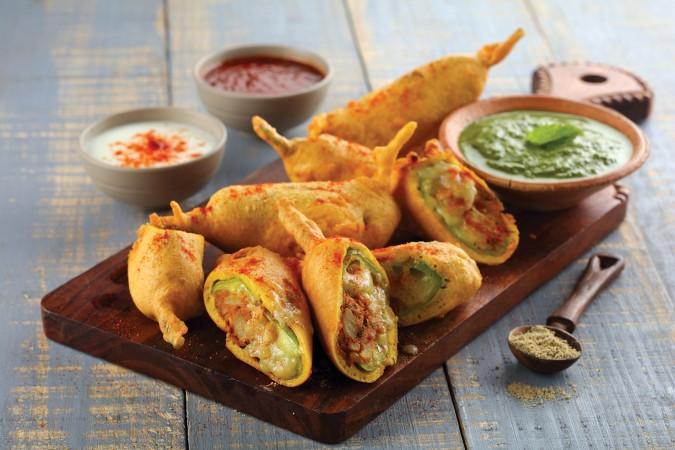
Mirchi Vada - © Mitali Vyas
Festivals & Local Celebrations
Marwar Festival
Time of Year: September to October
The Marwar Festival, also known as the Maand Festival, is one of the biggest celebrations in Jodhpur. Held over two days around the time of Sharad Purnima (the full moon of autumn), the festival takes place at the Mehrangarh Fort, Umaid Bhawan Palace, and Mandore. You can see captivating music and dance performances by local artists, depicting the heroic tales of Rajasthan's rulers. The festival also features polo matches and a camel cavalry procession called the Camel Tattoo Show.
Jodhpur International Desert Kite Festival
Time of Year: January 14th to 16th
The Jodhpur International Desert Kite Festival is a relatively new addition to the city's calendar, but it has quickly gained popularity. Held at the Polo Grounds, the festival attracts kite flyers from across India and abroad who compete to fly their kites higher and cut off their opponents' kites. With a chance to enjoy the colorful spectacle of kites filling the sky, accompanied by the release of balloons by school children and kite drops from Air Force helicopters.
Jodhpur RIFF (Rajasthan International Folk Festival)
Time of Year: September to October
The Jodhpur RIFF is a UNESCO-endorsed celebration of Rajasthan's folk music and culture. Held around the time of Sharad Purnima, the festival features performances by renowned artists from Rajasthan and abroad. You can experience a diverse range of musical styles, including Indo-Western collaborations and jazz nights, all set against the backdrop of the majestic Mehrangarh Fort.
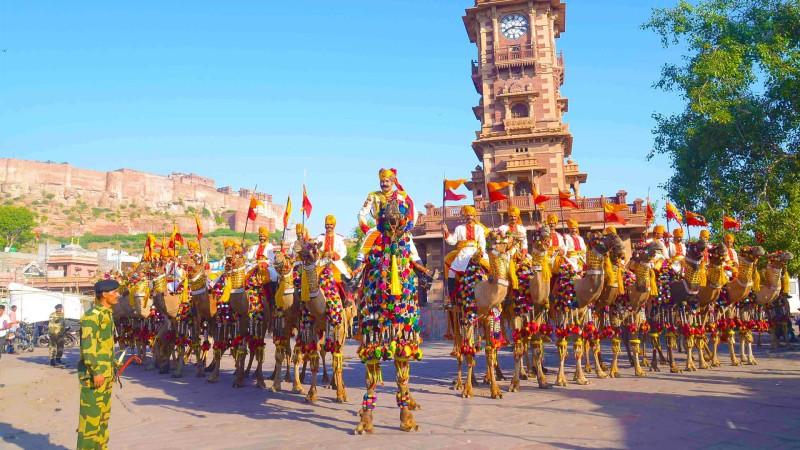
Marwar Festival - © gather
Weather in Jodhpur: Best Time to Visit
Jodhpur has a hot desert climate with very high temperatures year-round. The city is famously known as the "Sun City" due to its bright, sunny weather.
Temperatures
- Average Temperatures: Range from 33°C to 20°C (91°F to 68°F) annually.
- Summer (April to June): Daytime highs routinely exceed 40°C (104°F). The highest temperature on record is 48.8°C (119.8°F) set on May 20, 2016.
- Winter (December to February): Daytime temperatures range from 7°C to 25°C (45°F to 77°F). Nighttime lows can dip to around 10°C (50°F).
Rainfall
- Average Annual Rainfall: Around 362 mm (14.3 inches), mostly from June to September during the monsoon season.
- Rainfall amounts fluctuate greatly - from only 24 mm (0.94 in) in the drought year of 1899 to 1,178 mm (46.4 in) in the flood year of 1917.
Best Time to Visit
The most favorable time to visit Jodhpur is during the winter months from October to March when the weather is pleasant and ideal for sightseeing. Daytime highs range from 25°C to 31°C (77°F to 88°F) during this peak tourist season. Summers are extremely hot while the monsoon brings high humidity.
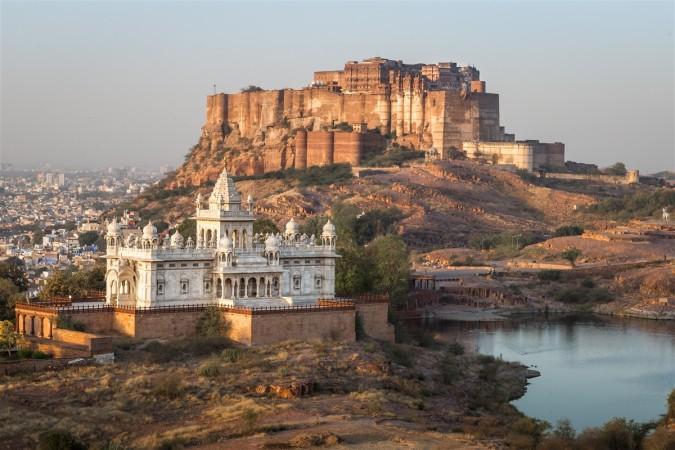
Jaswant Thada - © gather
Culture Etiquette in Jodhpur
Greetings
Namaste: It is customary to greet people with "Namaste" or "Namaskar," accompanied by folding your hands in front of your chest as a sign of respect. Addressing individuals with titles like "ji" (for respect) is also common.
Dress Modestly
You should dress modestly, especially when visiting religious sites. Both men and women should cover their shoulders and knees. Lightweight cotton clothing is advisable due to the hot climate.
Respect Religious Practices
When entering temples, it is customary to remove your shoes and, in some cases, cover your head. Avoid wearing leather products and touching holy books or idols with your feet, as this is considered disrespectful.
Photography
Always seek permission before photographing people, especially women and religious sites. Respect the privacy of locals and adhere to any photography restrictions in certain areas.
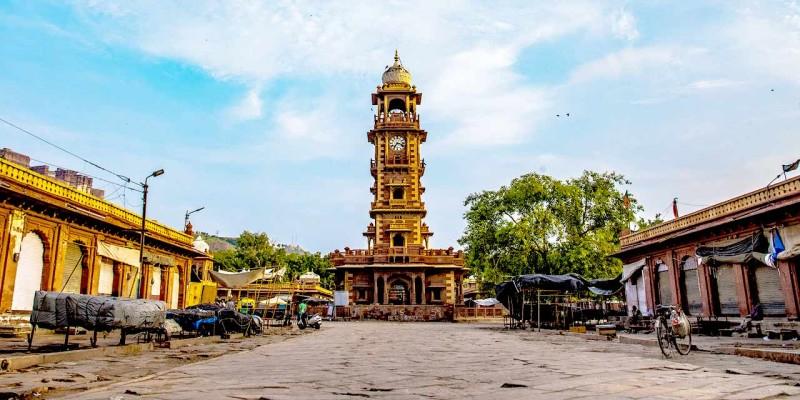
Clock Tower Jodhpur - © jodhpurtourism
Essential Travel Information
Getting to Jodhpur
Air
Jodhpur Airport: Located about 5 km from the city center, Jodhpur Airport serves both military and civilian flights. It offers direct flights to major cities like Delhi, Mumbai, and Bengaluru, operated by airlines such as Air India, Indigo, and SpiceJet. The airport has been undergoing expansion to accommodate increased traffic and flights.
Train
Rail Connectivity: Jodhpur is well-connected by train to various cities, including Delhi, Mumbai, and Jaipur. The railway station is located centrally, making it convenient for travelers. Booking tickets can be done online through the IRCTC website or via local travel agencies.
Bus
Bus Services: Jodhpur has a comprehensive bus network, with the main bus stand located at Paota. Rajasthan Roadways operates both government and private buses to nearby cities and states, including deluxe and Volvo services.
Getting Around Jodhpur
Taxis and Ride-Sharing
- Taxis: Pre-booked taxis are available from services like JCR Cab and Rajputana Cabs, offering airport transfers and local sightseeing tours. Prices start from around ₹500 for a sedan for airport transfers.
- Ride-Sharing: Uber operates in Jodhpur, but the number of available cars is limited, so travelers may experience longer wait times compared to larger cities. It's advisable to check for availability in advance.
Auto Rickshaws
Auto Rickshaws: Commonly used for short distances, auto rickshaws do not typically use meters, so it’s important to negotiate fares beforehand. Prices can often be inflated for tourists, so asking locals or hotel staff for guidance on reasonable rates is recommended.
Public Transit
Buses: Jodhpur has recently introduced a Bus Rapid Transit System (BRTS) with low-floor buses operating on major routes, providing an affordable way to navigate the city.
Accommodation Choices
Jodhpur offers a wide range of accommodation options to suit various budgets and preferences:
Luxury Hotels
- Umaid Bhawan Palace: A heritage hotel that was once the residence of the royal family, offering opulent rooms and exquisite dining options.
- Taj Hari Mahal: A luxurious hotel featuring traditional Rajasthani architecture and modern amenities.
Mid-Range Hotels
- Hotel City Palace: Centrally located with comfortable rooms and easy access to major attractions.
- Indana Palace Jodhpur: A blend of traditional and modern architecture with excellent facilities.
Budget Hotels and Guesthouses
- Zostel Jodhpur: A popular hostel for backpackers, offering dormitory-style accommodations and a vibrant atmosphere.
- Hotel Shree Ram International: A budget-friendly option with basic amenities and a convenient location.
Articles for you
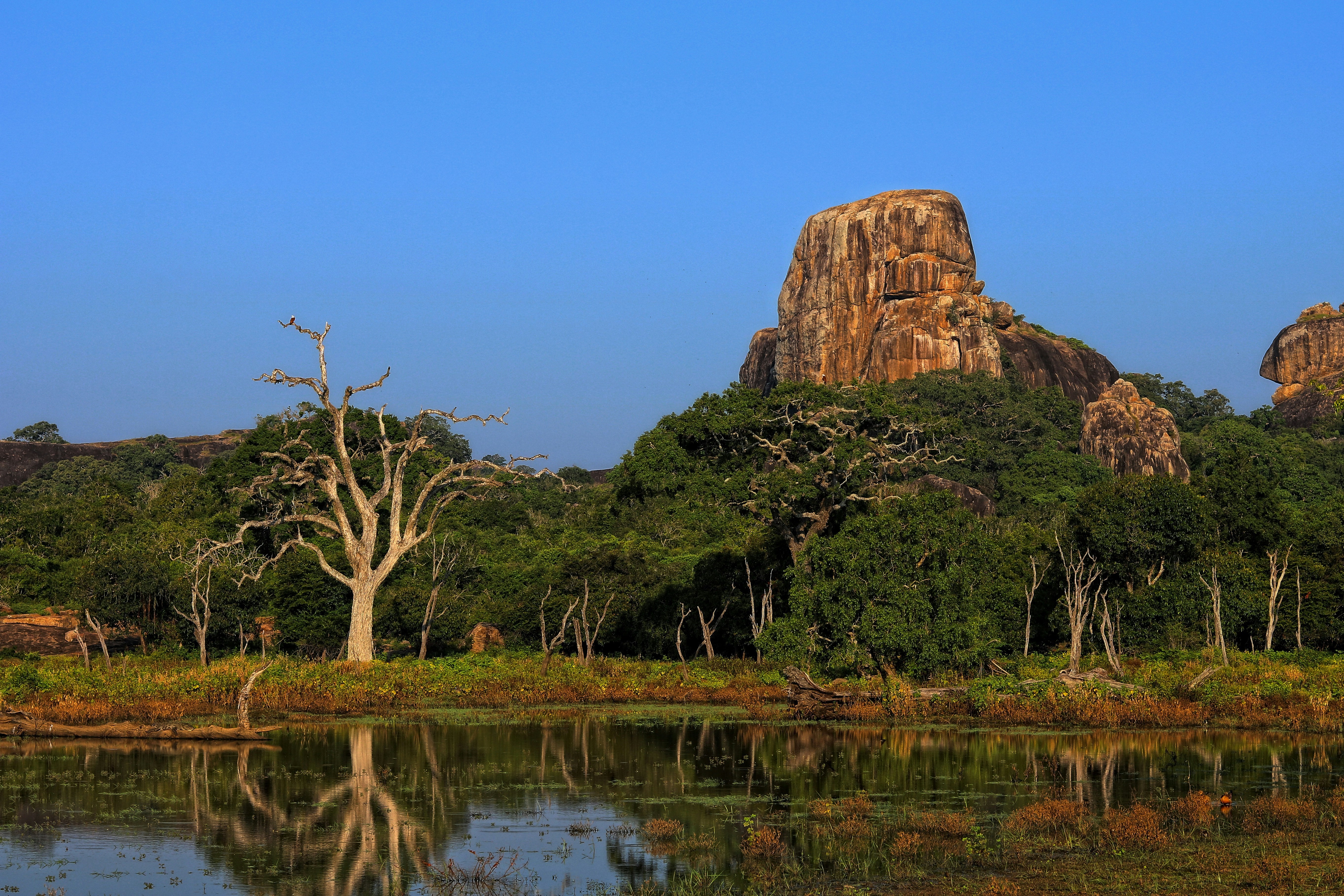
Explore Yala National Park - Sri Lanka Travel, Asia
Tucked away in Sri Lanka’s southeastern corner, Yala National Park is where wild nature meets deep tradition. Known worldwide for its leopard population, the park is also home to elephants, sloth bears, crocodiles, and hundreds of bird species. Beyond wildlife, Yala opens doors to a cultural landscape dotted with ancient temples, Buddhist ruins, and coastal villages. For travelers seeking more than just a safari, Yala offers a chance to explore eco-tourism, local communities, and sacred heritage sites.
Population: The Yala National Park area doesn’t have a human population.
Economy: The economy around Yala National Park thrives on a blend of eco-tourism, agriculture, and local services. Safari tours, eco-lodges, and cultural experiences drive steady income for nearby towns like Tissamaharama and Kataragama, supporting thousands of families.
Landmarks: Famous for Block I of Yala and wildlife encounters, including elephants, sloth bears, crocodiles, and exotic bird species.
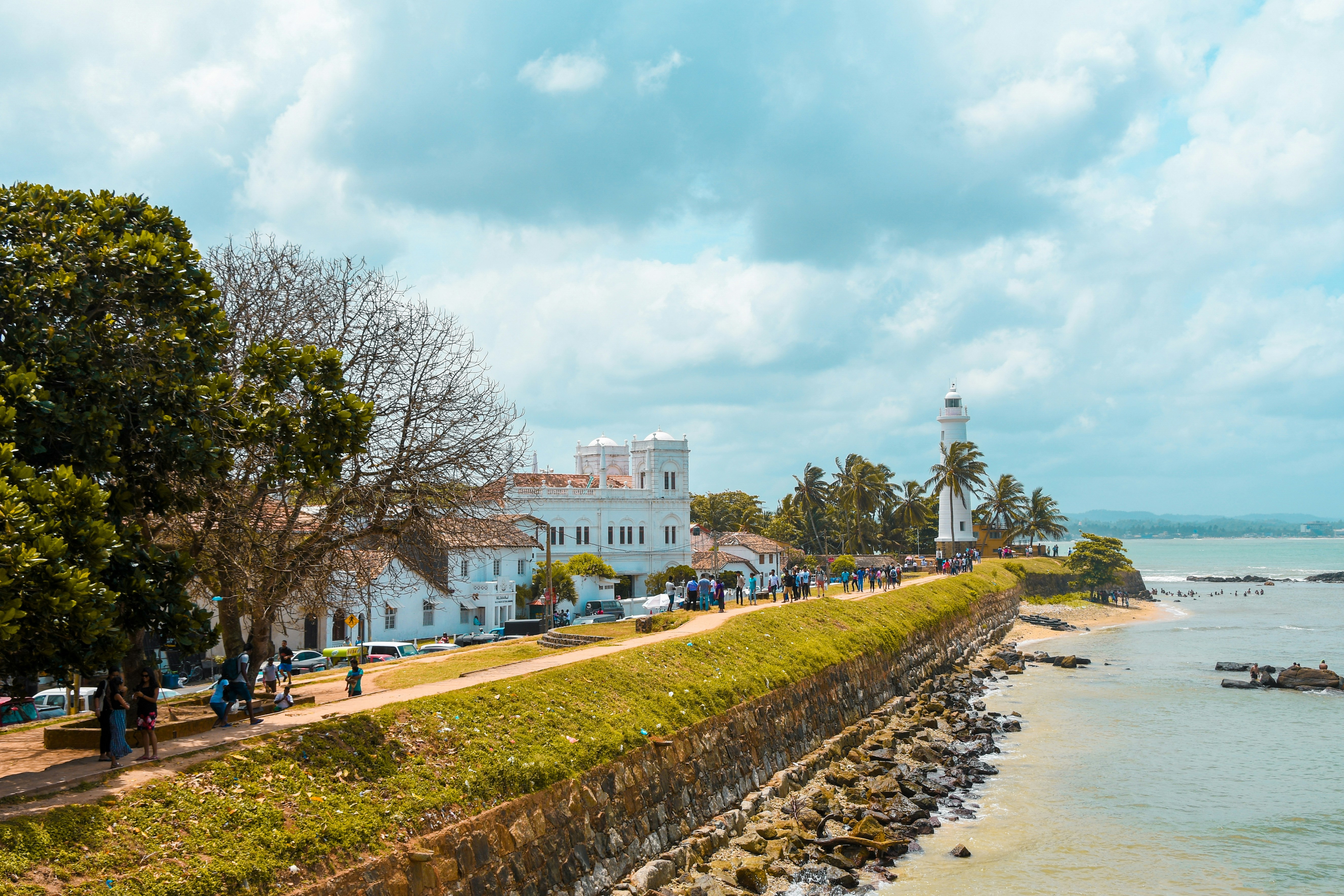
Explore Galle - Sri Lanka Travel, Asia
Nestled on Sri Lanka’s southern coastline, Galle is a vibrant city where history meets the sea. Its cobbled streets, colonial architecture, and serene beaches make it a must-visit destination for travelers seeking a blend of culture, adventure, and relaxation. A UNESCO World Heritage site, Galle captivates visitors with its Dutch Fort, bustling markets, and friendly locals. Whether you’re exploring the ramparts at sunset or savoring fresh seafood by the shore, Galle promises an unforgettable journey into Sri Lanka’s heritage.
Population: Approximately 113,000 in 2023.
Economy: Galle’s economy thrives on tourism, trade, and fisheries. The city’s historic fort, colonial architecture, and coastal charm draw thousands of international visitors each year, making tourism its main economic driver. Fishing remains vital for local livelihoods, supplying fresh seafood across the region.
Landmarks: Famous for the Galle Fort, Dutch Reformed Church & Maritime Museum, and Unawatuna Beach.
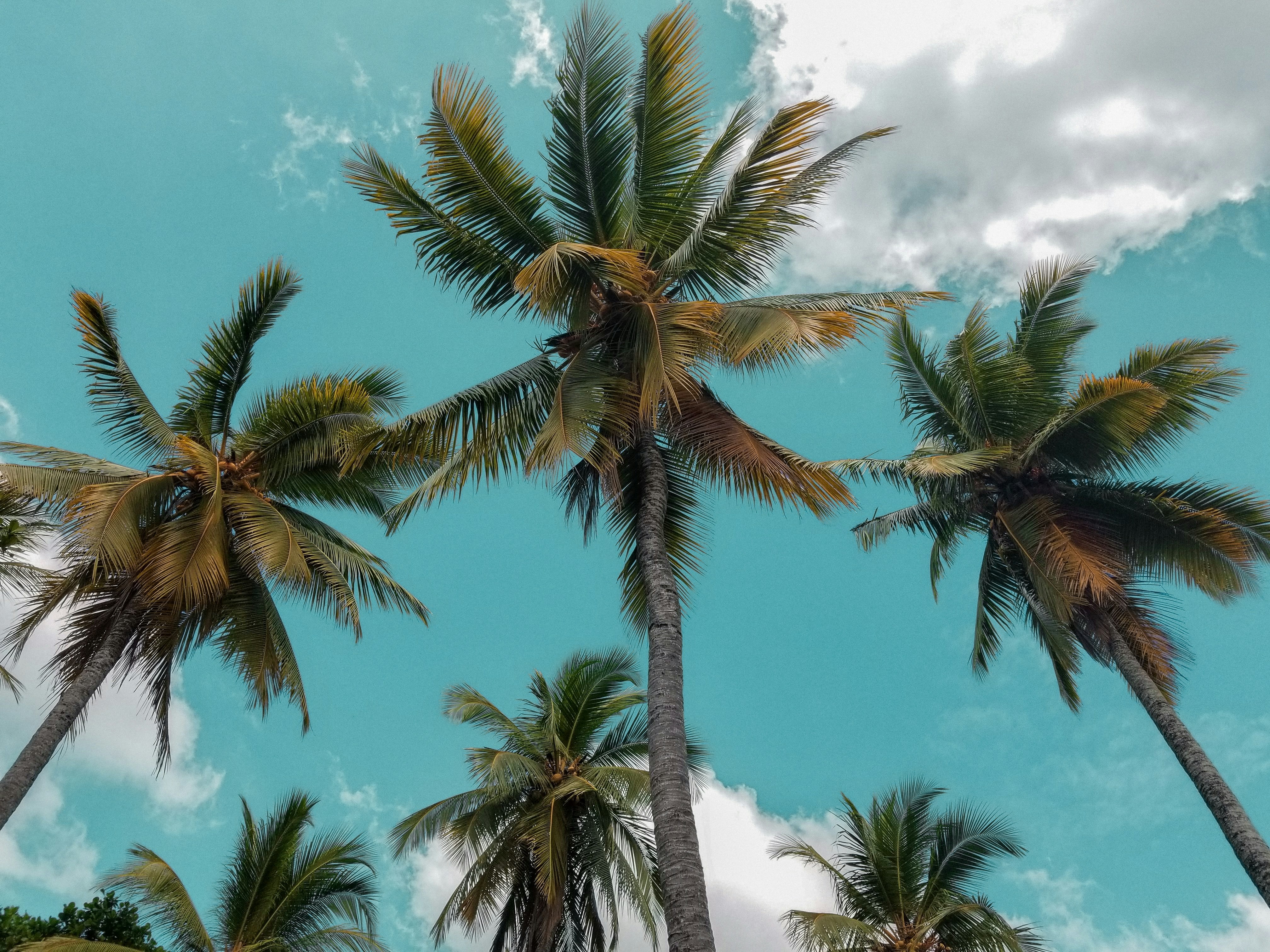
Explore Bentota - Sri Lanka Travel, Asia
Nestled along Sri Lanka’s southwestern coast, Bentota is a tropical paradise that blends golden beaches, vibrant culture, and thrilling adventures. Famous for its calm waters, luxury resorts, and scenic river estuary, Bentota has become a top destination for travelers seeking both relaxation and authentic experiences. From serene beach walks at sunrise to adrenaline-pumping water sports, this coastal town offers a perfect balance of leisure and exploration. With its proximity to Colombo and Galle, Bentota is easy to reach, making it an ideal stop for both short escapes and extended holidays.
Population: Approximately 37,000 in 2023.
Economy: Bentota’s economy thrives mainly on tourism, which drives local businesses such as hotels, restaurants, and wellness retreats. The town also benefits from fishing, coconut cultivation, and handicrafts like wood carving and batik textiles. Many residents rely on the growing demand for water sports and Ayurvedic treatments, making tourism the backbone of both income and employment in the area.
Landmarks: Famous for Bentota Beach, Bentota River Safari, and Kande Vihara Temple.
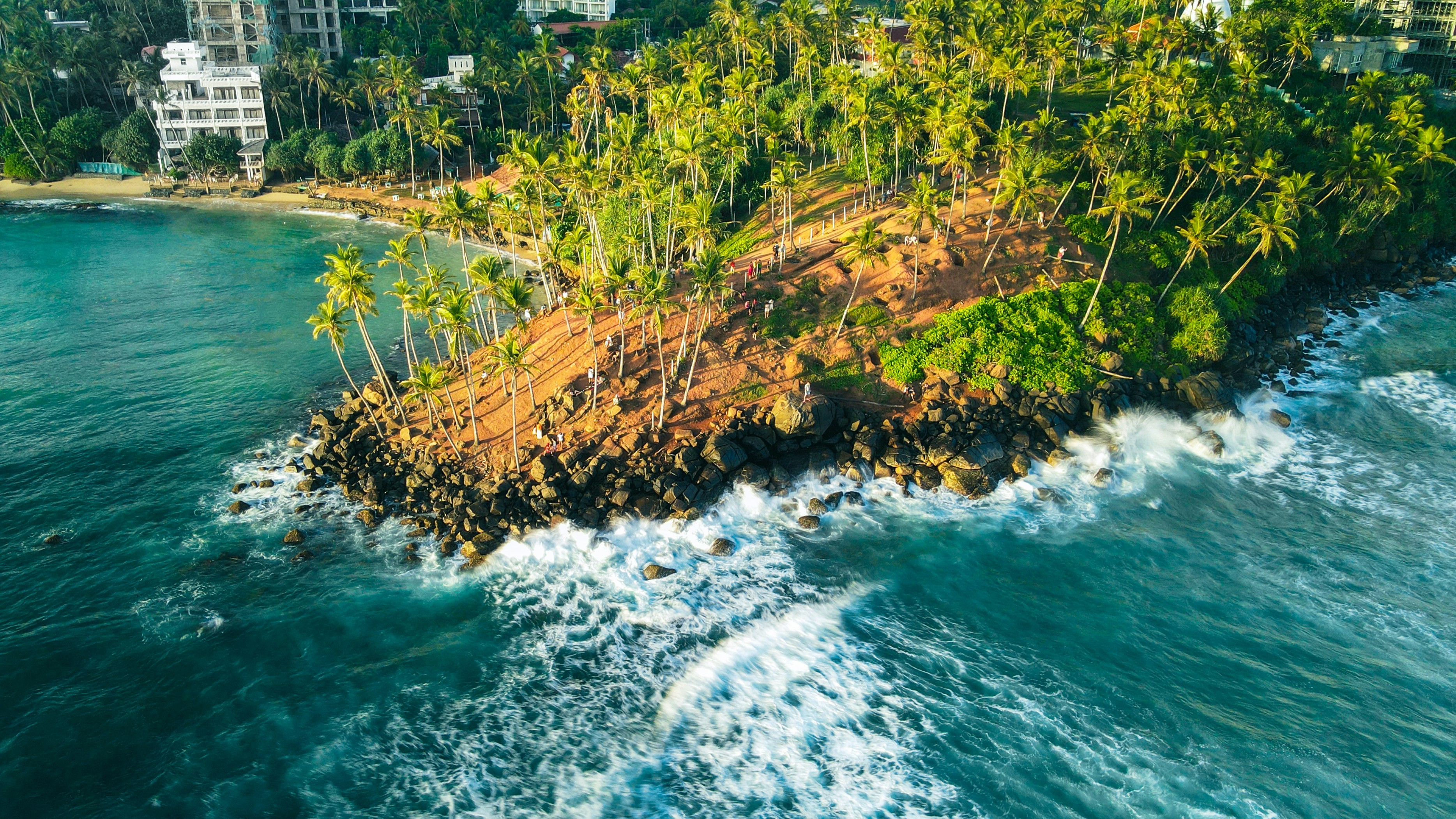
Explore Mirissa - Sri Lanka Travel, Asia
Mirissa is a charming coastal town on Sri Lanka’s southern shoreline. Known for its golden beaches, turquoise waters, and vibrant marine life, it has become a must-visit stop for travelers exploring the island. Many come for whale watching, surfing, and sunset views at Coconut Tree Hill, but Mirissa offers much more than postcard beauty. The fishing boats you see anchored by the bay carry generations of stories. Local traditions, delicious cuisine, and a laid-back rhythm of life shape every visitor’s experience.
Population: Approximately 4,700 in 2023.
Economy: Mirissa’s economy is largely shaped by its coastal location. Fishing has long been the backbone of local livelihoods, with generations relying on the Indian Ocean for income. In recent decades, tourism has become the main driver of growth, thanks to whale watching, surfing, and beachside hospitality.
Landmarks: Famous for Mirissa Beach, Coconut Tree Hill, and Parrot Rock Bridge.
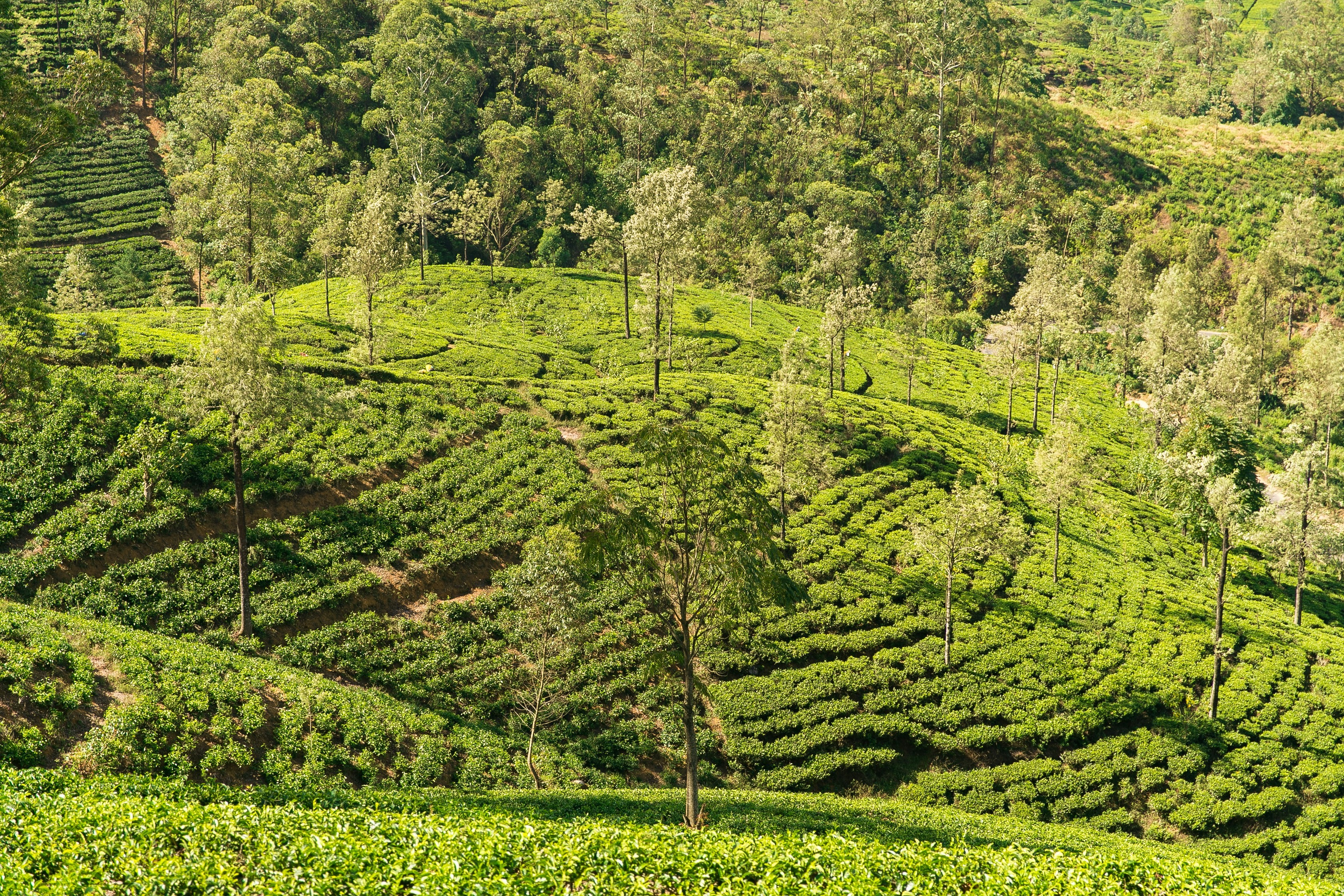
Explore Nuwara Eliya - Sri Lanka Travel, Asia
Tucked away in the Central Highlands of Sri Lanka, Nuwara Eliya is often called “Little England”. With its rolling tea plantations, cool misty mornings, and colonial charm, this mountain town feels like a step into another world. Travelers come here to breathe fresh air, walk through flower gardens, sip the finest Ceylon Tea, and enjoy a pace of life far from the island’s busy cities. Whether you’re drawn by scenic landscapes, heritage architecture, or the warmth of its people, Nuwara Eliya is a destination that blends nature, culture, and history in perfect harmony.
Population: Approximately 781,000 in 2023.
Economy: Nuwara Eliya’s economy thrives mainly on tea production, as it sits in the heart of Sri Lanka’s central highlands, famous worldwide for Ceylon Tea. The city also benefits from a growing tourism industry, attracting visitors with its colonial charm, cool climate, and scenic landscapes.
Landmarks: Famous for Gregory Lake, Hakgala Botanical Garden, and Victoria Park.
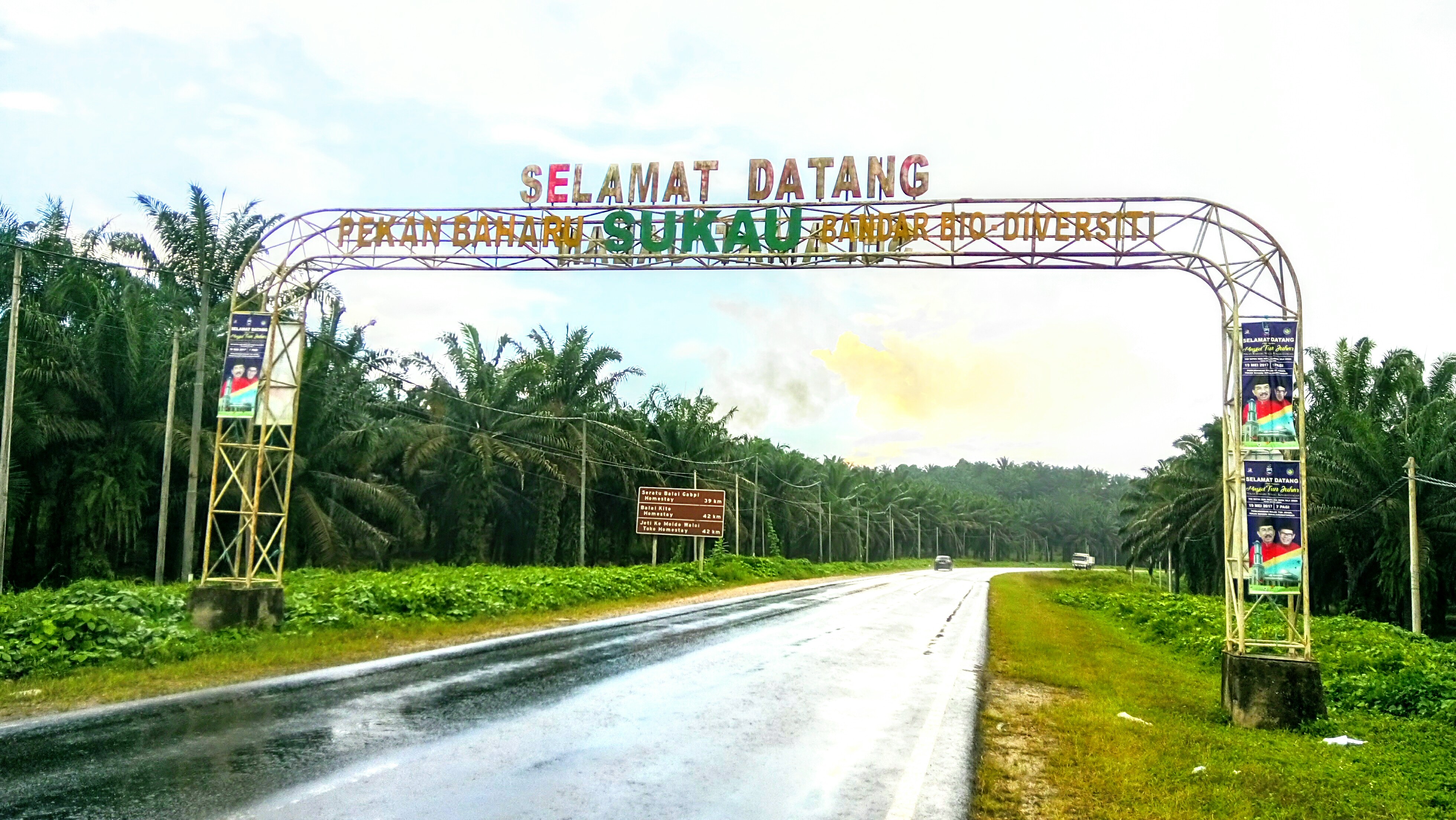
Explore Sukau - Malaysia Travel, Asia
Nestled on the banks of the Kinabatangan River in Sabah, Malaysian Borneo, Sukau is a destination where wildlife, culture, and conservation come together. Known as one of Asia’s top spots for river safaris and eco-tourism, this quiet village offers a front-row seat to encounters with Bornean orangutans, pygmy elephants, proboscis monkeys, and exotic birdlife.
Population: Approximately 1,400 in 2019.
Economy: Sukau’s economy is shaped by its riverine location and natural resources. Traditionally, the Orang Sungai community relied on fishing, small-scale farming, and forest gathering for their livelihood. Today, the village has shifted toward eco-tourism, with river cruises, jungle trekking, and homestays providing income.
Landmarks: Famous for the Kinabatangan River cruises, Gomantong Caves, and Ox-bow lakes and wetlands.
